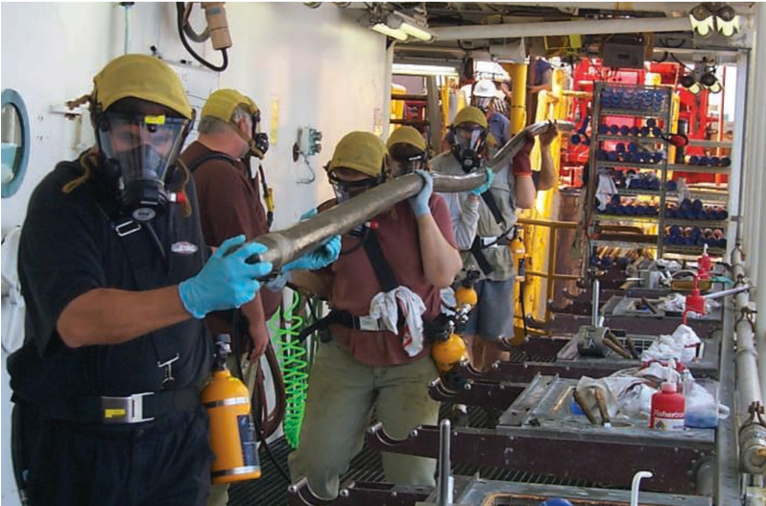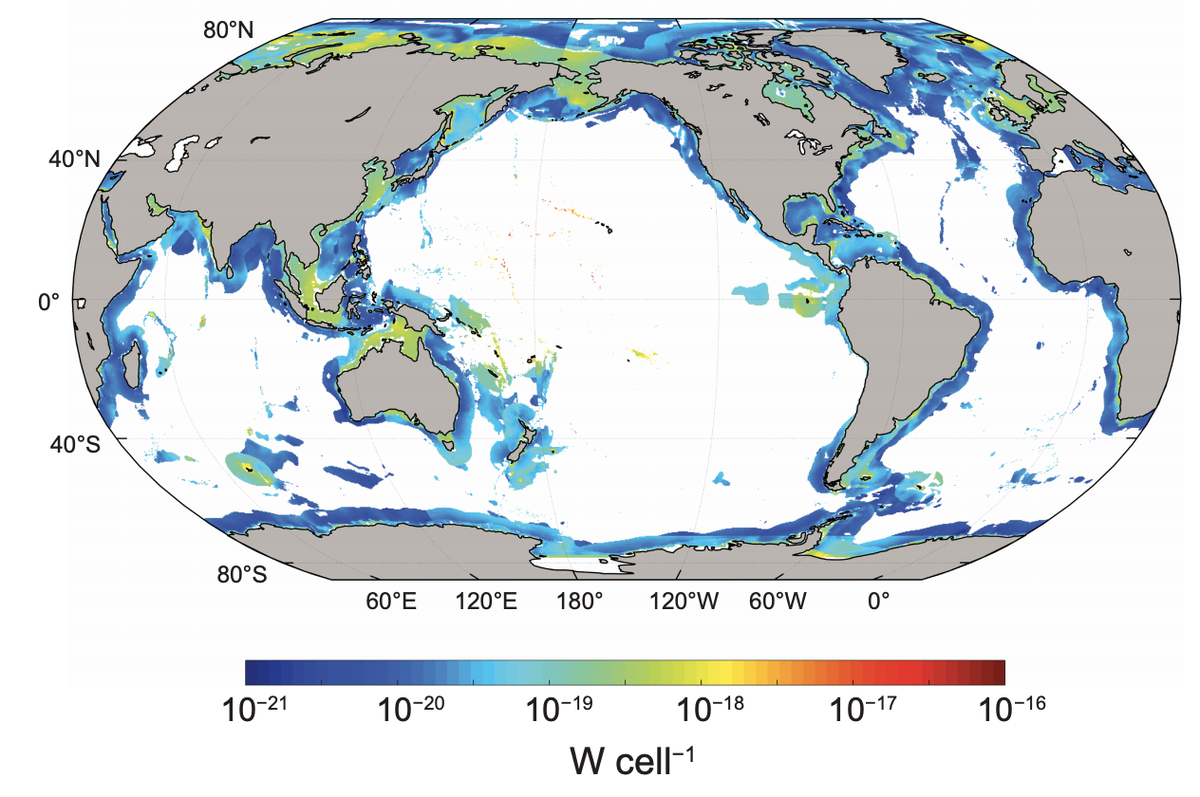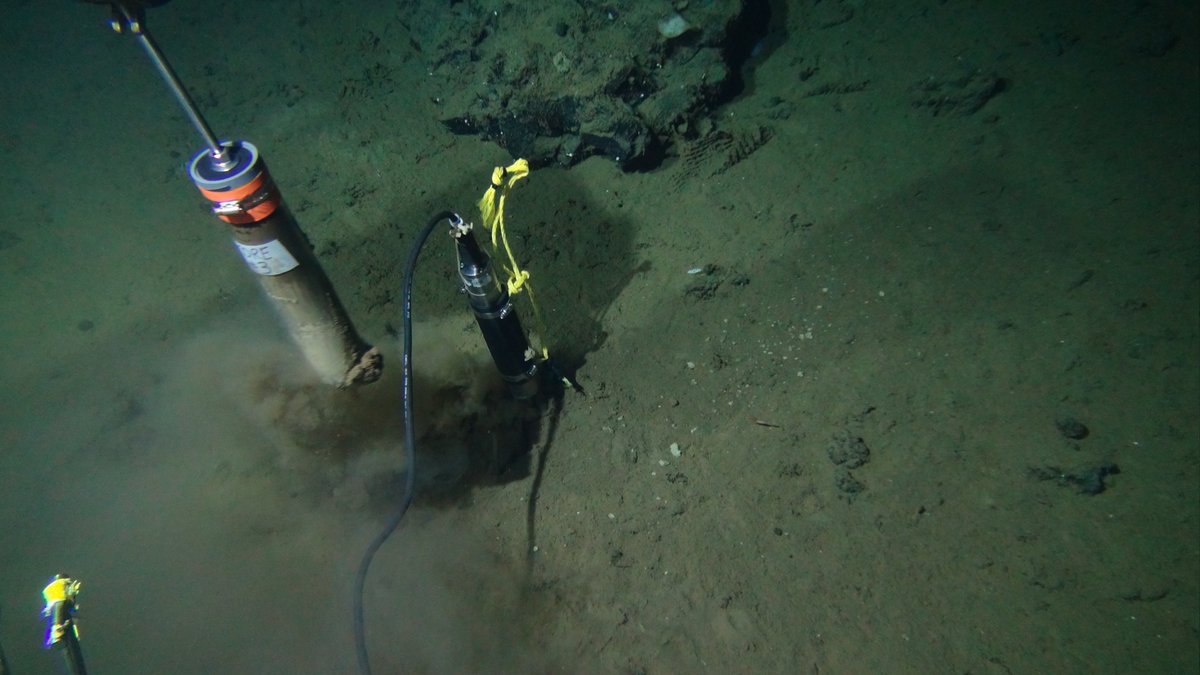Excited to share our new study out in @ScienceAdvances! We modelled Earth’s global subseafloor C cycle, and found that microbes survive on less energy than has previously been shown to support life.
A breakdown provided in the https://abs.twimg.com/emoji/v2/... draggable="false" alt="🧵" title="Thread" aria-label="Emoji: Thread"> below
https://abs.twimg.com/emoji/v2/... draggable="false" alt="🧵" title="Thread" aria-label="Emoji: Thread"> below
#OpenAccess paper: https://advances.sciencemag.org/content/6/32/eaba0697">https://advances.sciencemag.org/content/6...
A breakdown provided in the
#OpenAccess paper: https://advances.sciencemag.org/content/6/32/eaba0697">https://advances.sciencemag.org/content/6...
Subseafloor microbes comprise a significant portion of Earth’s biosphere and control global biogeochemical cycles. They survive under extreme energy limitation over extraordinary timescales, providing an analog to extraterrestrial settings and pushing the limits of life
All life needs energy. Where there is not enough energy, there can be no life. But how much is enough? Subseafloor microbes are thought to get by on very little energy, because ancient sediment layers have had no ‘fresh food’ deliveries for thousands, or even millions of years!
Here, we calculate the amount of energy subseafloor microbes use, and the global biogeochemical cycles they drive, in high resolution through space and time  https://abs.twimg.com/emoji/v2/... draggable="false" alt="🌎" title="Amerika auf dem Globus" aria-label="Emoji: Amerika auf dem Globus">
https://abs.twimg.com/emoji/v2/... draggable="false" alt="🌎" title="Amerika auf dem Globus" aria-label="Emoji: Amerika auf dem Globus">
We developed modelling approaches to calculate the subseafloor distribution of cells and electron acceptors, and organic C distribution, degradation and thermodynamics, globally in 3D. Then we calculate the power (energy per time) of all microbes in the global subseafloor habitat
We calculated organic C deposition, reactivity, degradation, and burial using a global reaction transport model, following an approach we recently published in @GCA_Journal: https://www.sciencedirect.com/science/article/pii/S0016703720304373">https://www.sciencedirect.com/science/a...
We also mapped the distribution of electron acceptors to predict the pathways of POC degradation. Previous work from @oceanegger as well as data from Ronnie Glud, Steve D’Hondt, Jens Kallmeyer and Rob Pockalny was critical in this effort. https://www.nature.com/articles/s41561-018-0122-8">https://www.nature.com/articles/...
With knowledge of the availability of terminal electron acceptors in each grid cell and depth horizon, we were able to use thermodynamic modelling to calculate the amount of catabolic energy generated from POC degradation
We took the best available model for the global distribution of subseafloor cells and interpolated it onto our grid – following Kallmeyer et al 2012 https://www.pnas.org/content/109/40/16213">https://www.pnas.org/content/1...
These combined efforts enabled us to simultaneously quantify the global distribution of cells and electron acceptors, the distribution, rate and energetics of organic carbon stored and degraded, and the energy regime for all sediments deposited in the last 2.6 million years
So what did we find?
Despite oxygen being widespread in abyssal sediments, we estimate that <3% of Quaternary sediments are oxic.
Oxic abyssal sediments are very much thinner (hundreds of meters thick) compared to anoxic coastal sediments (tens of kilometers thick)
Despite oxygen being widespread in abyssal sediments, we estimate that <3% of Quaternary sediments are oxic.
Oxic abyssal sediments are very much thinner (hundreds of meters thick) compared to anoxic coastal sediments (tens of kilometers thick)
Oxic sediments contain 6,800 Pg organic C. Encouragingly, this is similar to @emmoxiely ‘s estimate of 6,700 Pg C. It might sound like a lot - but in fact it’s less than 5% of all the POC stored in Quaternary subseafloor sediment https://www.nature.com/articles/s41561-018-0291-5">https://www.nature.com/articles/...
The rest of the organic C is contained in sulfate reducing sediment (83,000 Pg C) and methanogenic sediment (56,000 Pg C) – which are more widespread globally
Now for the energy. All living things require energy supplied at a rate sufficient to meet their power demands. Therefore, we should always consider energy per time (power). Power is the energy flux, measured in watts, or joules (energy) per second (time)
We calculate the combined power used by all microorganisms in subseafloor sediments amounts to 37.3 GW. This is:
- Roughly the same as the total power of Denmark
- Less than 0.1% of the power produced photosynthetically in the marine photic zone
- Roughly the same as the total power of Denmark
- Less than 0.1% of the power produced photosynthetically in the marine photic zone
Power is derived mostly from oxic POC degradation (54.5%), despite oxic sediment comprising a minor fraction of total sediment volume and POC
We calculate that the average sediment-dwelling microbe uses 30 zeptowatts - which is ~2 orders of magnitude lower than the lowest experimentally derived power for microorganisms, and five orders of magnitude lower than the lowest culture-based estimates! https://sfamjournals.onlinelibrary.wiley.com/doi/abs/10.1111/j.1462-2920.2010.02178.x">https://sfamjournals.onlinelibrary.wiley.com/doi/abs/1...
By the way, zepto is a unit prefix which means a factor of 10^−21 or 0.000000000000000000001
Just think about that for a second...
Just think about that for a second...
For context, a human uses ~100 watts (100 joules per second). This is about the same power as a ceiling fan, a sewing machine, or two lightbulbs.
We calculate that the average microbe trapped in deep sea sediments survives on fifty-billion-billion times less energy than this.
 https://abs.twimg.com/emoji/v2/... draggable="false" alt="🤯" title="Explodierender Kopf" aria-label="Emoji: Explodierender Kopf">
https://abs.twimg.com/emoji/v2/... draggable="false" alt="🤯" title="Explodierender Kopf" aria-label="Emoji: Explodierender Kopf">
We calculate that the average microbe trapped in deep sea sediments survives on fifty-billion-billion times less energy than this.
Over 80% of buried microbes subsist at less than 190 zeptowatts - the lowest previous estimate of the basal power limit to life https://www.frontiersin.org/articles/10.3389/fmicb.2015.00718/full">https://www.frontiersin.org/articles/...
Globally, we see stepwise decreases in microbial power utilization that largely follow the redox state of the sediment:
Aerobic heterotrophs: 2,000 zW per cell
Sulfate-reducers: 100 zW per cell
Methanogens: 15 zW per cell
Aerobic heterotrophs: 2,000 zW per cell
Sulfate-reducers: 100 zW per cell
Methanogens: 15 zW per cell
Surprisingly, oxic sediments - characterized by low cell abundance – have relatively ‘high’(er) power cells. But remember: these sediments sustain microbes for millennia with extremely low mortality rates (shout out to recent @NatureComms paper) https://www.nature.com/articles/s41467-020-17330-1">https://www.nature.com/articles/...
Coastal regions– thought of by many as ‘high-energy’ because of high POC, are in fact extremely power-limited on a PER CELL basis in the deeper layers. Here we see high mortality – evidenced as sharp declines in cell abundance with sediment depth
You can think of it like this:
Coastal zone = lots of organic C but orders of magnitude higher cell concentrations, thus many more mouths to feed.
Oxic ocean gyre = low organic C and very few microbes, thus significantly more food going around PER MICROBE.
Coastal zone = lots of organic C but orders of magnitude higher cell concentrations, thus many more mouths to feed.
Oxic ocean gyre = low organic C and very few microbes, thus significantly more food going around PER MICROBE.
Nevertheless, the sustained presence of microbes, even in deeper anoxic, low-energy layers, indicates that at least a fraction of the microbes are capable of surviving at energy fluxes far lower than that has been calculated for any natural environment previously!
This work rests on three major assumptions/uncertainties, which we test to ensure our conclusions hold.
1. Rate of POC degradation. We test the entire plausible ranges of parameters. Microbes are energy-starved whichever way you look at it.
1. Rate of POC degradation. We test the entire plausible ranges of parameters. Microbes are energy-starved whichever way you look at it.
2. Gibbs energy of the catabolic pathways. We vary critical values such as the concentration of reactants and products, yet doing so produces only minor changes in cell energy regime.
3. The number of cells carrying out the reaction. We assume that all cells present are carrying out the metabolism prescribed to it. Yet we know of other metabolisms at play - so we also did simulations where cell abundance is varied by up to 50%
But this doesn’t affect powers so much. Energy regimes vary over many orders of magnitude, which vastly supersedes the impact of, for example, changing cell abundance by a factor of 2
Under all tested scenarios, the percentage of microorganisms subsisting at less than 190 zW is at least 65%— underscoring the highly energy-limited nature of microorganisms in subseafloor sediments
So what does this all mean? An extension to the habitable boundaries of life on Earth and elsewhere? An entire subseafloor biosphere that doesn’t grow, divide, or evolve? A seed-bank acting to maintain biodiversity over geological timescales?
Deep marine sediments and the life they contain become more and more extraordinary, the more we learn about them. If microbes can survive on Earth on zeptowatts of power, perhaps life still exists in the subsurface of Mars long after it was habitable, or even thrives on Europa
Thanks to co-authors @dugdammit @sandrarndt @amend_lab @oceanegger @burwicz and Andy Dale, and funders @deepbiosphere @NSF @NASAAstrobio @USC @deepcarb @EU_H2020 @NERCscience and @AvHStiftung  https://abs.twimg.com/emoji/v2/... draggable="false" alt="🍻" title="Anstoßende Bierkrüge" aria-label="Emoji: Anstoßende Bierkrüge">
https://abs.twimg.com/emoji/v2/... draggable="false" alt="🍻" title="Anstoßende Bierkrüge" aria-label="Emoji: Anstoßende Bierkrüge">

 Read on Twitter
Read on Twitter










